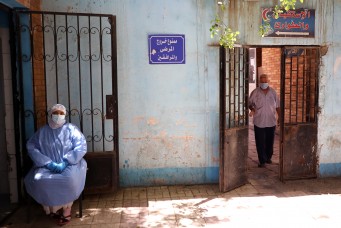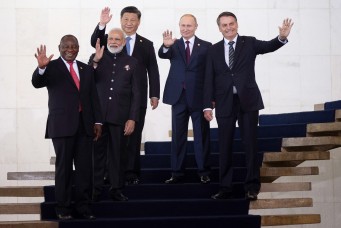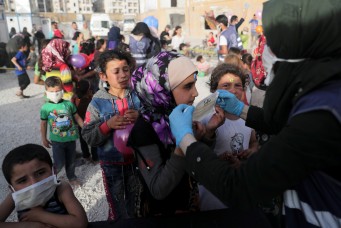Reviving Enterprises in the Time of COVID-19
To keep enterprises afloat and save those that have incurred financial losses due to the lockdown, decisive and inclusive government action is necessary.

A pedestrian wearing a mask walks past a closed business in Boston, Massachusetts, USA, 14 April 2020. EPA-EFE/CJ GUNTHER
In the two months that lockdown measures have been put in place around the world, governments have been caught in a tug-of-war between economic interests and the fight to save lives. The human toll of the coronavirus that surfaced in 2019 is almost incomprehensible—over 215,000 deaths worldwide—and the economic reckoning paints a picture of more casualties to come from poverty, evictions, and food insecurity, amongst other factors. More than 22 million Americans have filed for unemployment since the beginning of the crisis, and 81 percent of the global workforce has been affected by full or partial lockdown conditions according to International Labour Organization (ILO) data.
This is the quandary that governments have to deal with as they struggle with the decision to reopen businesses amidst the COVID-19 pandemic—and there’s no one clear answer. In the United States, protests to end state lockdowns have even manifested at state capitols in Utah, Wisconsin, and Virginia, among others as some governors have resisted White House calls to go back to business. This public discontent makes the relationship between economic and health interests shockingly tangible, and spurs the conversation surrounding the role of governments in addressing economic downturn and helping struggling enterprises back to their feet.
In a special webinar entitled “Public Policy Interventions to Support Enterprises During the COVID-19 Crisis”, hosted by the American University in Cairo’s School of Global Affairs and Public Policy on April 28, Enterprise Development Specialist at the ILO’s Decent Work Team for North Africa Miguel Solano drew upon ILO recommendations to build a roadmap for resurrecting the global economy.
Solano began by identifying three phases of what economies go through during and following a pandemic: generalized reduction in economic activity; reactivation of business activity; and recovery. Though the first phase has been a common global experience—different institutions have estimated that the global economy will lose anywhere from $1 trillion to $5 trillion in 2020—different countries have progressed between the first and second phases on different timelines.
That’s not to say that all workers, however, are experiencing the pandemic equally. Micro, small, and medium-sized enterprises (MSMEs), tourism, retail, manufacturing, and hospitality sectors, and informal economy workers are particularly vulnerable.
Just as specialized care may need to be taken with these workers, each phase of reopening will require a different policy. In the initial phase, governments can support enterprises to temporarily convert their production to help respond to the pandemic: General Motors, Tesla, Ford, Nissan, and Formula 1 have shifted to ventilator production, while Fiat has begun producing masks. This is an example of the way the needs to retain jobs and simultaneously save lives from COVID-19 can be reconciled.
Meanwhile, governments can help other enterprises adapt to new market conditions, like physical distancing. They can make tools for maintaining communication, like WhatsApp, more readily available, support digital payment channels, and provide web-based training on digital marketing and service delivery. In Egypt, Solano says, more and more businesses are coming online and advertising on social media.
Lastly, governments can help enterprises cover fixed costs. They can offer temporary subsidies to cover labor costs, conditional on employment retention and based on enterprise size, which Solano says is happening more in wealthy countries.
Or they can encourage financial institutions to reschedule repayments, as he points out was the case in Latin America. Canada is providing enterprises with grants at “replacement rates” for fixed costs, which are based on previous tax filings over the past two to three years. These means of easing access to credit and other financial services are “sort of a mantra at all levels of the pandemic”, Solano says.
The second stage will shift its focus to consumers: to survive in the long-term, “what companies need is customers with cash to spend,” Solano notes. At this point, governments will need to roll out a demand policy—they can stimulate demand through employment-intensive investment (with preference given to MSMEs), give tax incentives to stimulate local sourcing of multinational enterprises, and craft campaigns to restore consumer confidence.
The COVID-19 crisis has also made countries acutely aware of their vulnerability to supply chain disruptions, as well as of the need for a more agile and responsive business environment. One remedy may be to build digital marketing platforms across cities, subnational regions, and even neighboring countries.
However, despite our best efforts, the private sector—particularly in those vulnerable communities—will exit the pandemic as a damaged good. The priority of the third phase of reopening will be to spur recovery as quickly as possible, while incorporating building blocks toward a more sustainable future. MSMEs would benefit from programs to boost productivity improvement, expand the number of technical schools that help entrepreneurs enhance management capacities, or to provide vouchers so that new entrepreneurs can access the expertise of business service providers. Governments should consider some interventions that will help the informal economy direct its operations to less-saturated sectors. Lastly, investment in infrastructure could improve enterprises’ access to supplies and markets and help them reach more customers.
All three of these phases need to be marked by tripartite social dialogue between governments, enterprises, and workers for an inclusive and time-bound response. Alternatives for layoffs through reduced work time and reorganization of business operation and flexible methods to keep business operations running should be central topics of discussion, and can even be taken up at the bipartite level as well to be most effective.
Solano also emphasized that government transparency is a precondition to effective response. “Governments do have an obligation to provide timely and up-to-date information about containment measures,” he offers as a reminder.
The better they provide information, the better enterprises can forecast and plan. Moreover, without transparency, it will be impossible to guarantee full occupational safety and health to essential workers—another responsibility assumed by governments.
Though he gives a number of specific recommendations, “We need to be creative to come up with solutions,” Solano enjoins.
Sydney Wise is contributing editor at the Cairo Review of Global Affairs. Her past work has been published at the Boston Consortium for Arab Region Studies. On Twitter: @sydneyywisee
Read MoreSubscribe to Our Newsletter





